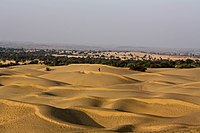
Photo from wikipedia
Sorghum halepense (L.) Pers is a common and noxious worldwide weed of increasing distribution in many European countries. In the present review, information on the biology, ecology, agricultural, economic and… Click to show full abstract
Sorghum halepense (L.) Pers is a common and noxious worldwide weed of increasing distribution in many European countries. In the present review, information on the biology, ecology, agricultural, economic and environmental impact of johnsongrass is given, and the current status of this weed in Europe is discussed. Furthermore, special attention is given to the important role of field trials using glyphosate to control weeds in arable and perennial crops in many European countries. Some of the factors which affect control efficacy and should be taken into account are also discussed. Finally, several non-chemical alternative methods (cultural, mechanical, thermal, biological, etc.) for johnsongrass management are also presented. The adoption of integrated weed management (IWM) techniques such as glyphosate use, crop rotation, and deep tillage is strongly recommended to control plant species that originate from both seed and rhizomes.
Journal Title: Agronomy
Year Published: 2019
Link to full text (if available)
Share on Social Media: Sign Up to like & get
recommendations!